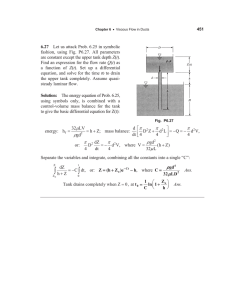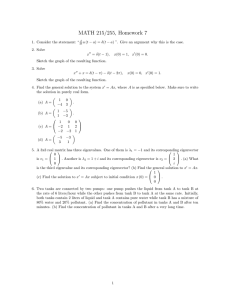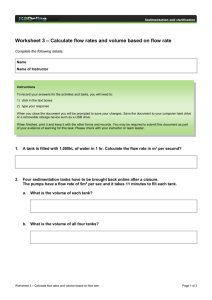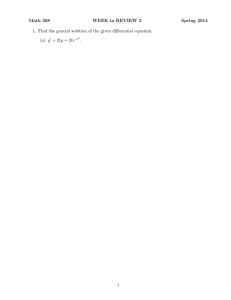Research Journal of Applied Sciences, Engineering and Technology 5(22): 5286-5292,... ISSN: 2040-7459; e-ISSN: 2040-7467
advertisement
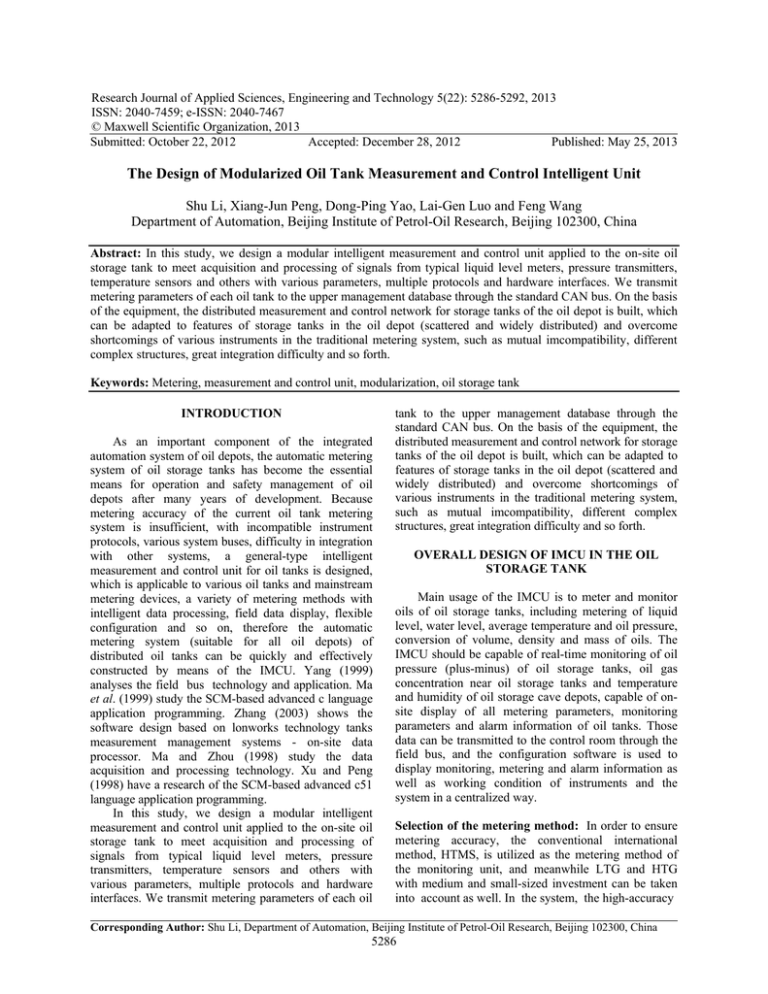
Research Journal of Applied Sciences, Engineering and Technology 5(22): 5286-5292, 2013 ISSN: 2040-7459; e-ISSN: 2040-7467 © Maxwell Scientific Organization, 2013 Submitted: October 22, 2012 Accepted: December 28, 2012 Published: May 25, 2013 The Design of Modularized Oil Tank Measurement and Control Intelligent Unit Shu Li, Xiang-Jun Peng, Dong-Ping Yao, Lai-Gen Luo and Feng Wang Department of Automation, Beijing Institute of Petrol-Oil Research, Beijing 102300, China Abstract: In this study, we design a modular intelligent measurement and control unit applied to the on-site oil storage tank to meet acquisition and processing of signals from typical liquid level meters, pressure transmitters, temperature sensors and others with various parameters, multiple protocols and hardware interfaces. We transmit metering parameters of each oil tank to the upper management database through the standard CAN bus. On the basis of the equipment, the distributed measurement and control network for storage tanks of the oil depot is built, which can be adapted to features of storage tanks in the oil depot (scattered and widely distributed) and overcome shortcomings of various instruments in the traditional metering system, such as mutual imcompatibility, different complex structures, great integration difficulty and so forth. Keywords: Metering, measurement and control unit, modularization, oil storage tank INTRODUCTION As an important component of the integrated automation system of oil depots, the automatic metering system of oil storage tanks has become the essential means for operation and safety management of oil depots after many years of development. Because metering accuracy of the current oil tank metering system is insufficient, with incompatible instrument protocols, various system buses, difficulty in integration with other systems, a general-type intelligent measurement and control unit for oil tanks is designed, which is applicable to various oil tanks and mainstream metering devices, a variety of metering methods with intelligent data processing, field data display, flexible configuration and so on, therefore the automatic metering system (suitable for all oil depots) of distributed oil tanks can be quickly and effectively constructed by means of the IMCU. Yang (1999) analyses the field bus technology and application. Ma et al. (1999) study the SCM-based advanced c language application programming. Zhang (2003) shows the software design based on lonworks technology tanks measurement management systems - on-site data processor. Ma and Zhou (1998) study the data acquisition and processing technology. Xu and Peng (1998) have a research of the SCM-based advanced c51 language application programming. In this study, we design a modular intelligent measurement and control unit applied to the on-site oil storage tank to meet acquisition and processing of signals from typical liquid level meters, pressure transmitters, temperature sensors and others with various parameters, multiple protocols and hardware interfaces. We transmit metering parameters of each oil tank to the upper management database through the standard CAN bus. On the basis of the equipment, the distributed measurement and control network for storage tanks of the oil depot is built, which can be adapted to features of storage tanks in the oil depot (scattered and widely distributed) and overcome shortcomings of various instruments in the traditional metering system, such as mutual imcompatibility, different complex structures, great integration difficulty and so forth. OVERALL DESIGN OF IMCU IN THE OIL STORAGE TANK Main usage of the IMCU is to meter and monitor oils of oil storage tanks, including metering of liquid level, water level, average temperature and oil pressure, conversion of volume, density and mass of oils. The IMCU should be capable of real-time monitoring of oil pressure (plus-minus) of oil storage tanks, oil gas concentration near oil storage tanks and temperature and humidity of oil storage cave depots, capable of onsite display of all metering parameters, monitoring parameters and alarm information of oil tanks. Those data can be transmitted to the control room through the field bus, and the configuration software is used to display monitoring, metering and alarm information as well as working condition of instruments and the system in a centralized way. Selection of the metering method: In order to ensure metering accuracy, the conventional international method, HTMS, is utilized as the metering method of the monitoring unit, and meanwhile LTG and HTG with medium and small-sized investment can be taken into account as well. In the system, the high-accuracy Corresponding Author: Shu Li, Department of Automation, Beijing Institute of Petrol-Oil Research, Beijing 102300, China 5286 Res. J. Appl. Sci. Eng. Technol., 5(22): 5286-5292, 2013 P1 (KPa) = P2 (KPa) = H (m) = LP (m) = LG (m/s2) = Sum of static oil pressure (measured through the pressure sensor P1) and steam pressure The steam pressure measured through the pressure sensor P2 The liquid level measured through the liquid level meter Mounting height of the pressure sensor P1 Local acceleration of gravity Apparent volume: Vobs may be obtained through lookup of the oil strapping table as per the liquid level (H): Fig. 1: Measurement parameters and calculation method Mass: = M D(V0bs + V0 ) liquid level meter is used to measure the liquid level of oils, the average temperature sensor for temperature of oils, the pressure transmitter for oil pressure and oil tank steam pressure (plus-minus), these parameters are acquired through the measurement & control unit, and then oil density, volume and mass are obtained through calculation in accordance with the strapping table for internal storage. Measurement parameters and the calculation method are shown in Fig. 1: The formula used here is expressed as follows: Apparent density Densobs = where, P1 P 2 ( H LP) LG V0 = The volume (a constant) below the measuring plate. Compatible sensors with IMCU: The intelligent unit is designed to have modularized hardware interfaces, with communication protocols (for many instruments) integrated in the firmware, and the unit is compatible with the following instrument interfaces: Radar, servo and magnetostrictive liquid level meters with RS-485 interface and Modbus communication protocol, the smart pressure transmitter with Hart signal output, the average temperature sensor with PT100 platinum resistor, the oil gas concentration sensor and the ambient temperature and humidity sensor with 4-20 mA analog output, etc. Fig. 2: Structure and configuration of SCADA system in the oil storage tank 5287 Res. J. Appl. Sci. Eng. Technol., 5(22): 5286-5292, 2013 Fig. 3: Hardware module structure of measurement and control unit Overall structure of the system: Measurement and control network structure of the SCADA system in the oil storage tank of the oil depot includes three layers, the bottom layer is used to place the primary instrument, mainly including the liquid level meter, the average temperature sensor, the pressure transducer, the combustible gas concentration sensor, the ambient temperature and humidity sensor and so forth; the medium layer is the distributed field bus control network, mainly including intelligent measurement and control unit of the oil storage tank, the field bus network etc; the top layer is the monitoring and metering management system for the oil storage tank based on the Ethernet network, mainly including the central monitoring station, monitoring configuration software, database and so on. The system structure is illustrated in Fig. 2. HARDWARE STRUCTURE AND FUNCTION IMPLEMENTATION OF THE MEASUREMENT AND CONTROL UNIT To meet different requirements for the monitoring system of oil storage tanks, hardware of the measurement and control unit is designed according to the modular design idea, mainly including the master control platform module, the serial port module, the onoff input and output module, the current analog input module, the RTD module and the keyboard module. The module structure is illustrated in Fig. 3. provided with electrostatic protection, filtering protection and isolation etc. The module of power supply provides a 24 V input, a 24 V output and a RS232 connector. The sub-module of power supply is designed as Fig. 4. ColdFire V4-series high-performance processor, MCF54415, is used in the CPU module, with a 128 M on-board DDR2 RAM, a 256MB on-board NAND FLASH and a 4 MB on-board SPI FLASH, which can satisfy acquisition, operation and storage of large volume data as well as other requirements. Multichannel I2C, SPI, UART and GPIO signals included in MCF54415 are extended out through the backplane so as to achieve control of other modules in the case and communication with them. RS485, CAN and RS232 are extended out from the front panel to implement communication and networking with other measurement and control units at different distance. USB and the Ethernet communication connectors are reserved for node maintenance and other communication. The CPU module is equipped with one USB interface, one Ethernet connector, one CAN connector, one RS485 connector and one RS232 connector. The CPU sub-module is designed as Fig. 5. Design of serial communications module: The serial port module is mainly used to connect RS485-based MTS magnetostrictive liquid level meter, SABB Radar liquid level meter and the servo liquid level meter manufactured by Honeywell-Enraf Company, which is applied to acquisition of liquid level, water level of oils in storage tanks and other data. The UART signal of the CPU module is transmitted out through the backplane of the serial port module, and changed into RS485 and RS232 (signal) to achieve communication between the measurement and control node and field instruments. The serial port module provides three RS485 channels and two RS232 channels outwards. The serial port module is designed as Fig. 6. Module design of the master control platform: The master platform module includes sub-modules of power supply and CPU, module extension backplane inside. The sub-module of power supply supports switch of DC24V to DC5V and DC3.3V, which provides power for other modules in the case from the backplane connector. The UART signal of the CPU module is transmitted out from the backplane and changed into RS233 (signal) to communicate with the external intelligent liquid crystal terminal. DC24V input of the Design of analog input module: The analog input power supply is equipped with surge protection, burst module is mainly used for acquisition of 4-20 mA protection, electrostatic protection, and reverse output signals from the pressure transmitter, the connection protection and so on. RS232 connector is 5288 Res. J. Appl. Sci. Eng. Technol., 5(22): 5286-5292, 2013 Fig. 4: Hardware structure of power supply in the master control platform Fig. 5: Hardware structure of CPU module in the master control platform Fig. 6: Hardware structure of serial port module 5289 Res. J. Appl. Sci. Eng. Technol., 5(22): 5286-5292, 2013 Fig. 7: Hardware structure of analog input module Fig. 8: Hardware structure of RTD module combustible gas concentration sensor, the ambient temperature and humidity sensor, which are mounted on the oil storage tank. UART, SPI and GPIO signals of the CPU module are transmitted out through the backplane of the AI module. SPI and GPIO are connected to the ADC channel to achieve 4-20 mA signal detection of field instruments. A 24 bit chip with the SPI connector is used in ADC, in which the Analog Front End (AFE) is integrated to reduce the total channel error. The UART is connected with the MODEM to realize communication with the HARTbased field instrument (for instance, ROSEMOUNT 3051-series pressure transmitters). The AI module provides 6 4-20 mA input connectors, of which three are capable of HART communication. The analog input module is designed as Fig. 7. Design of RTD module: The RTD module is used to acquire temperature signal of the average temperature sensor based on the PT100 platinum resistor, and signals of 4 temperature spots at most may be measured. SPI and GPIO signals of the CPU module The RTD module are transmitted out through the backplane of the RTD module to connect the ADC channel, so as to implement sampling of the two-wiresystem/three-wire-system Pt100 resistor, and to detect the temperature parameter with an error of less than 0.1°C. A 24 bit chip with the SPI connector is used in ADC, in which the Analog Front End (AFE) is integrated to reduce the total channel error. The RTD module provides 4 two-wire-system/three-wire-system resistor connectors. The RTD module is designed as Fig. 8. 5290 Res. J. Appl. Sci. Eng. Technol., 5(22): 5286-5292, 2013 Fig. 9: Software flow pattern DI/DO module: The DI/DO module is utilized to acquire alarm signal input of the liquid level switch and the oil-gas concentration senor, to provide control output of the on-site audible and visual alarm and to control on-off action of valves, and so on. I2C and GPIO signals are transmitted from the backplane of the DI/DO module to connect I/O expansion chips, so as to implement input detection of on-site dry contacts and control output of relays. The DI/DO module provides four dry-contact inputs, four 24VDC/3A and 220VAC/1A relay outputs outwards. connected to the Lon Works MODEM to realize networking of nodes and external Lon Work’s bus equipment. The keyboard module provides one 9-wire keyboard scan interface and one Lon Works bus interface outwards. SOFTWARE DESIGN OF MEASUREMENT AND CONTROL NODES Software design of measurement and control nodes should abide by the software engineering design philosophy of “Top-down Design, Stepwise Detailing”, Keyboard module: I2C, GPIO and UART signals of mainly including the configuration module, the bus the CPU module are transmitted out through the transmission module, the serial-port signal acquisition backplane of the keyboard module, I2C and GPIO are module, the analog input acquisition module, the RTD connected with the keyboard scan chip to achieve scan acquisition module, the HART signal acquisition of the external 4×5 keyboard and obtain the input module, the processing module of switching values, the command from the keyboard, which is used for the oncomputation and display module, the man-machine site operators to set oil tank type, Offset of data, the interaction module etc. The software program flow is measuring range and other parameters displayed on the illustrated as Fig. 9. measurement and control unit. The UART signal is 5291 Res. J. Appl. Sci. Eng. Technol., 5(22): 5286-5292, 2013 Module configuration: The practical condition applied to the measurement and control unit is mainly configured by means of the information inputted by users from the keyboard module, furthermore the following parameters are selected through reading of matrix keyboard input, such as types of oil tanks, height configuration of oil tanks, safety capacity, safety height, mounting position of pressure transducers, collocation of metering devices, selection of metering methods, oil tank strapping table, storage of petroleum density conversion table, and so forth. CAN bus transport module: The module is mainly used to ensure reliable communication between the measurement and control unit and the upper computer, key data exchanged with the upper computer includes liquid level, water level, temperature, density, volume, mass, oil gas concentration, ambient temperature and humidity, alarm status etc. CAN2.0A supports the acceptance code with an 11-bit ID, and acceptance codes corresponding to the acceptance code registers (AC.7 to AC.0) are ID.10 to ID.3. In the unit, CAN is mainly used to upload the data-frame format in a realtime way and to transmit the real-time data acquired through the measurement and control unit to the upper computer. The real-time uploaded frames include an 8bit oil tank number, a 16-bit liquid level, a 16-bit water level, a 16-bit temperature, a 32-bit volume, a 16-bit density, a 32-bit mass, all states and frame information (32-bit). Serial signal acquisition module: Software design is performed mainly according to the liquid level based on the modbus communication protocol. For magnetostrictive, radar and servo liquid level meters, data acquisition is implemented by means of the function code (03 or 04) to obtain liquid level, water level, temperature and other information specified in the communication protocol for all liquid level meters from data frames, and to monitor running status of devices through the function code 06. The RTU transmission mode is utilized in the liquid level meter chosen for the measurement and control unit, each byte in the message includes two 4-bit hexadecimal characters. The data request command format of the liquid level meter is specified as a 10-bit number including a 1-bit start bit, an 8-bit data bits and a 1-bit stop bit. The Baud rate is programmable and its default value is 9600. During communication, the master processor sends request to the liquid level meter, and the liquid level meter will make a response. The general format of Question is as follows: And the general format of Answer is as follows: Different Function Codes stand for diverse functions, for example, 03 means reading data of size n. Diverse information included in the Information item differentiates these two formats, and different functions have diverse meanings. The CRC16 check code is computed by the sender, the receiver will compute it again after getting the code and compare it with the CRC16 code sent before and otherwise it will not respond in the case of any difference. Analog input module: The module is mainly used for acquisition of 4-20 mA signal and HART signal from the pressure transmitter. After initialization of SPI and ADC in the module, the controlling word is written into ADC for self-calibration and setting of the cut-off frequency and gain of the filter. Because the measured signal is a low-frequency one, interference of the highfrequency signal can be eliminated by setting the cutoff frequency of the low pass filter as 40 Hz. The Gain is assumed to be 1 and the crystal oscillator Frequency (F) of ADC is 2.048 MHz, therefore the sampling frequency of ADC is Gain×F/256 = 8 KHz. Transition time determined by the cut-off frequency of the low pass filter is 1/40 Hz, namely 25 ms. After that the normal mode is used and 6-channel inputs are acquired in a cyclical way. Due to limited length of this paper, other module design will not be covered. CONCLUSION The module-based intelligent measurement and control unit (for oil storage tanks) designed in this paper meets online real-time monitoring requirement for oil tank parameters of various oil tanks and oils in refined oil depots, and achieves on-site display and alarm to make operation personnel of the oil depot be able to know safety status of the oil tank before the oil tank is mounted so as to avoid any serious accident. The unit supports multiple hardware interfaces and protocols, benefits establishment of a unified technical standard and reduces system integration difficulty and overlapping investment risk, which is of great significance for improvement of automatic monitoring and management level of oil depots. REFERENCES Ma, M. and C. Zhou, 1998. Data Acquisition And Processing Technology. Xi'an Jiaotong University Press, China. Ma, Z., S. Ji, K. Zhang and Y. Ma, 1999. SCM-based Advanced C Language Application Programming (Revised Edition). Beijing University of Aeronautics and Astronautics Press, China. Xu, A. and X. Peng, 1998. SCM-based Advanced C51 Language Application Programming. Publishing House of Electronics Industry, China. Yang, X., 1999. Field Bus Technology and Application. Tsinghua University Press, Beijing. Zhang, Y., 2003. Software design based on LonWorks technology tanks measurement management systems - on-site data processor. M.A. Thesis, Hebei University. 5292
